|
|
Post by Seth Drakin of Monster Crap on Oct 22, 2007 11:25:36 GMT -5
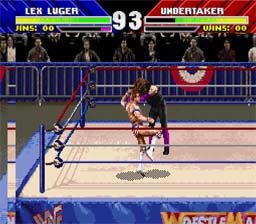 91. WWF Wrestlemania: The Arcade Game WWF WrestleMania (also known on console versions as WWF WrestleMania: The Arcade Game) is a professional wrestling arcade game released by Midway. Despite being based on professional wrestling, the game's digitized graphics and fast-paced gameplay make it more of a fighting game in the vein of Midway's Mortal Kombat series. The game is regarded as over the top for its use of attacks - such as the Undertaker using purple fireballs and Shawn Michaels wielding a baseball bat for his attack. Ports were made for Sega Mega Drive/Genesis, SNES, PlayStation, Sega Saturn, and PC. The game was followed up by WWF In Your House for the PlayStation and Sega Saturn. Wrestlers Are: * Bret "The Hitman" Hart * Doink the Clown * Lex Luger * Razor Ramon * Shawn Michaels * The Undertaker The ports had minor or major changes depending on the system. For example, the SNES version does not feature the endings of the Arcade version, and also lacks two characters: Bam Bam Bigelow and Yokozuna. It was rumored that Bigelow could be played in the European version via a cheat code. However, this has been proven false. There was also a popular rumor that Adam Bomb was available on the Sega 32X version of the game. This too, was proven false. Commentary was provided by Vince McMahon and Jerry Lawler, who also appear in the game sitting at the announcer's table to the right of the ring. |
|
|
|
Post by Seth Drakin of Monster Crap on Oct 22, 2007 11:41:14 GMT -5
Now for the countdown update
150. King Of The Monsters
149. Captain America And The Avengers
148. Bugs Bunny Rabbit Rampage
147. Cannon Fodder
146. Wayne's World
145. Madden NFL 95
144. Metal Warriors
143. Super Godzilla
142. Spider-man & Venom: Separation Anxiety
141. Clay Fighter
140. Super Bomberman 2
139. X-Men: Mutant Apocalypse
138. Kirby's Avalanche
137. Striker
136. Fatal Fury Special
135. King Of Dragons
134. Rap Jam: Volume One
133. Disney's Magical Quest
132. Doom
131. Samurai Shodown
130. International Superstar Soccer
129. Breath Of Fire
128. Sim City 2000
127. U.N. Squadron
126. Desert Strike: Return To The Gulf
125. Daffy Duck: The Marvin Missions
124. Super Battleship
123. S.O.S.
122. Gradius III
121. Tetris 2
120. Lufia II: Rise Of The Sinistrels
119. The Lion King
118. Spider-man & Venom: Maximum Carnage
117. Demon's Crest
116. Pinball Fantasies
115. Inindo: Way Of The Ninja
114. World Cup Striker
113. Run Saber
112. NCAA Football
111. Krusty's Fun House
110. The Simpsons: Virtual Bart
109. Cool Spot
108. Tecmo Secret Of The Stars
107. Super Caesar's Palace
106. Pilotwings
105. Road Runner's Death Valley Rally
104. Romance Of The Three Kingdoms IV: Wall Of Fire
103. Teenage Mutant Ninja Turtles: Tournament Fighters
102. Riddick Bowe Boxing
101. Saturday Night Slam Masters
100. Super Return Of The Jedi
99. Shadowrun
98. Kirby's Dream Course
97. Rock N' Roll Racing
96. NHL 94
95. Madden NFL 97
94. Paladin's Quest
93. Axelay
92. Advanced Dungeons & Dragons: Eye Of The Beholder
91. Wrestlemania: The Arcade Game
Here Are The Hints To The Next Five Games On Our List
* Defeat Beruga
* Hard, Lawn, Or Clay
* Has It All....Experience Sheer Brilliance
* Real World, Goblin Underworld, & Cloud World
* Tim Hardaway Is On The Cover
|
|
|
|
Post by gmanquik on Oct 22, 2007 11:57:12 GMT -5
Ooh, Super Tennis is coming up  |
|
|
|
Post by Seth Drakin of Monster Crap on Oct 22, 2007 14:11:23 GMT -5
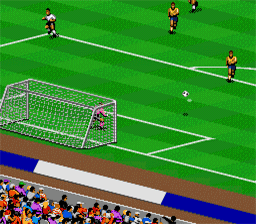 90. FIFA International Soccer Sometimes also known as FIFA '94, the first game in the series was released in the weeks before Christmas 1993. This greatly hyped football title broke with traditional 16-bit era games by presenting an isometric view rather than the usual top-down view (Kick Off), side view (European Club Soccer), or bird's-eye view (Sensible Soccer). It only includes national teams. The Sega Mega CD version includes some features from the next title, and is a highly polished version of the original. A notorious bug allows the player to score directly from an apposing goal kick by standing in front of the goal keeper so that the ball rebounds off him into the net. In 1995 a PC CD-ROM version was released featuring a new video introduction, player name editor, new music, and running commentary by Tony Gubba. The gameplay and graphics are exactly the same as the floppy disk version, except for the above "rebounding goal kick" flaw being fixed. |
|
|
|
Post by Seth Drakin of Monster Crap on Oct 22, 2007 14:13:27 GMT -5
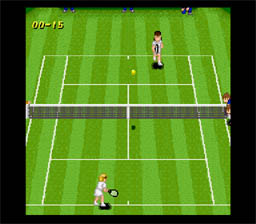 89. Super Tennis Super Tennis is a 1991 tennis video game for the Super NES. The game itself features three different modes, Singles mode, in which you can compete against a human or chosen computer opponent, doubles mode, in which you and a human team-mate can face the cpu, or you can each pair with a CPU opponent, or even one player can pair with a CPU opponent to face two other computer opponents. Finally, Circuit mode, featuring a wide range of tours you battle through each tournament to earn yourself ranking points and aim to finish number one in the rankings. There are four minor tournaments and four major tournaments, each taking place on a different surface, Hard, Lawn or Clay. A big advantage to the games gameplay is the differences in each court, and it is possible, just like a real human player that one can become accustomed to the bounce and speed of one type of court, but struggle on another. This enables different tactics to be used to defeat an opponent, to making your game more solid on your weaker surfaces. Another advantage are the characters to choose from. There are 20 characters to choose, 10 male and 10 female, each with different characteristics and styles of play. |
|
|
|
Post by Seth Drakin of Monster Crap on Oct 22, 2007 14:15:17 GMT -5
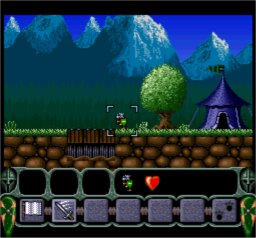 88. King Arthur's World King Arthur's World is a 1993 side-scrolling strategy game for the Super NES. It was developed by Argonaut Games and published by Jaleco. In the game, the player controls King Arthur. At the start of each level, only the King is present, but various types of troops can be brought out of the tent where he starts. The King and his troops can be commanded to move in a direction, which they do until they receive new orders, are killed or come across enemy troops, which they fight if they can. Also, some troops have special commands, such as for archers to fire arrows. The aim of each level is to proceed from the tent at the start, to the finishing point. This may require the player to defeat various enemies, avoid traps and obstacles. King Arthur is the only essential character. If he dies, the player has failed, and play can only continue if 100 gold coins are spent to rescue him, in which case the player restarts at his/her tent. The game can be played with the SNES control pad or, alternatively, with the SNES Mouse, as it is one of the few third Party games that support the device. |
|
|
|
Post by Seth Drakin of Monster Crap on Oct 22, 2007 14:19:27 GMT -5
.gif) 87. Terranigma Terranigma, known in Japan as The Creation of Heaven and Earth, is a 1995 action role-playing game for the Super Nintendo Entertainment System developed by Quintet and published by Enix. It is the story of the resurrection of the world, and its progress from prehistoric times to the near future. Terranigma was scored by Miyoko Kobayashi and Masanori Hikichi, the game's characters were designed by Kamui Fujiwara. As Enix no longer had an American subsidiary, Terranigma never saw the light of day in the United States, but was released in Europe and Australia, then published by Nintendo. Terranigma keeps an almost constant top-down perspective view of the world, with only a few brief side-scrolling parts in the game. Instead of turn based battles, which were common for most RPGs at this time, Terranigma utilizes an action-based combat system that allows the player to perform different attacks depending on whether or not the protagonist is running, jumping, tapping the attack button, or using a combination of these three techniques. Each attack is meant to be suited for dealing more damage to certain kinds of enemies, but most of them will take the same amount from any technique, regardless of the type used. There are five different attacks in the game: * Standard - A normal stab performed by pressing the attack button once. * Rushing - An attack where the player launches a quick flurry of stabs, but the damage inflicted per hit is dramatically decreased. Performed by rapidly tapping the attack button. * Slicer - A very quick piercing attack useful for hitting enemies that move around quickly. This attack can also be used to dodge projectiles flung from enemies. Performed by first running, then hitting the attack button. While executing this move, the player is immune to damage from the majority of enemy attacks. By performing multiple Slicer attacks in quick succession, the player is essentially invincible. * Spinner - A technique where the player jumps into the air and attacks. This can hit flying or hovering enemies. * Slider - A wider attack where the player jumps into the air and slants his pike towards the ground, causing him to hit and slide on the ground for a short distance. Performed by first jumping in a run, then hitting the attack button. This technique can hit flying or hovering enemies. The only form of defense is the X-Guard, where Ark crosses his spear in front of him, forming an X. This can only block small projectiles, such as tiny fireballs. However, it remains ineffective against melee attacks. The games protagonist uses different kinds of spears throughout the game. As new weapons are obtained, the attack power of the hero increases. Many spears in turn have unique properties which suit them to different situations during combat, the same applies to armor pieces. For example, there is equipment which can protect the player from fire attacks and inflict critical damage on enemies in cold areas. In towns, no visible status bars can be seen, and the player cannot attack at all. When being in dungeons and areas in which enemies are present, the status bar appears, displaying the character's level, hit points, Gem count (money), and items equipped. The status bar is rearrangeable by pausing the game and pressing the R button on the controller. On the overworld map, where the player travels between towns and dungeons, the view utilizes Mode 7 graphics and appears wrapped around to convey the spherical shape of the Earth. The player then appears significantly smaller, unlike other RPGs in which the same sprite is used for towns, dungeons, and the overworld. Terranigma also has a unique magic system. Rather than using magic points that decrease when casting spells, as most traditional RPGs have, all spells take the form of one-time-use items called "spell rings". Each ring is used up when the protagonist casts the item's corresponding spell. Players can acquire more spell rings by taking items called Magirocks to the various magic shops found in the game and transforming them into different rings. New spell ring types are usually obtained after defeating a boss. Due to the limited quantity of Magirocks in the game (97 in the Japanese, one less in other language versions), the fact that many players do not realize that Magirocks can be reused (once the item they were transformed in is used up, the same Magirock can be used again to make other spells) and because physical attacks can destroy most enemies just as easily as with using spells rings, most gamers see the magic system as somewhat lacking in this game. However, many players see collecting Magirocks as a form of unintentional mini-game in and of itself, and strive to ferret out the locations of all the Magirocks scattered throughout the main game. In Terranigma, the earth is portrayed as a hollow sphere that has both an external and internal face. Since the beginning of the earth, the external Lightside, the overworld, stood for growth whereas the internal Darkside, the underworld, represented decline. Over the course of billions of years, these two forces came to be called Good and Evil. Regardless of the inner antagonism, rapid progress took root and primitive life forms evolved to plants, animals and humans. Technology and industry revolutionized the evolution, but the fight between Good and Evil was still taking place, more fiercely than ever. The conflict culminated in a final battle at the southernmost point of the overworld. However, none of the two forces was victorious. The continents of the overworld submerged into the ocean and the underworld was sealed away. Ark is a troublemaker of a boy who lives in Crysta, the only village in the underworld. After opening a door he was told not to enter and touching a mysterious box inside, every citizen in the village is frozen. The only person not affected by the curse, the Elder of Crysta, guides him to resurrect the continents of the world in order to unfreeze the people. A way out of his hometown appears, and for the first time ever a human being leaves Crysta to explore the underworld which is portrayed as a frozen wasteland of imposing crystal mountains, crossed by rivers of magma. He conquers the trials of the five towers - each representing one continent - and revives the mainland of the earth. Upon returning to his hometown, the Elder instructs him to travel to the overworld and to resurrect all living beings. With a heavy heart, Ark says goodbye to his lifelong devoted friend Elle and sets out to the Lightside. Having crossed a dimensional crevasse that closed itself after his appearance on the overworld, Ark is confronted with the barren land that once was the Earth's surface. His first task is to free the giant tree Ra from the parasite he is afflicted with. This causes the resurrection of all plants in the world resulting in Ark's being able to cross the mountains of Guyana. He travels further into the world, reviving birds, the wind, animals and eventually mankind. After that, the Elder appears to Ark in a dream and tells him to keep helping humankind grow, as the world is still in the fledgling stages. He continues his journey, traveling and expanding cities, assisting with the invention of groundbreaking technologies and ultimately, freeing the ingenious Beruga from his sleep in a cryogenic chamber. The professor provides Ark with an insight into his personal image of the paradise. He envisions a perfect world by killing all insignificant life with a virus named Asmodeus and turning everyone else into immortal beings. Ark tries to attack Beruga after this revealing twist but is stopped by robots, injuring him heavily. The Elder once again appears to him, saying that his mission is fulfilled and he may now pass away. Ark realizes that he's been used by Evil to lead the power which created him to world domination. Just as he is about to die, Kumari, a wise human who watched the world's growth through reincarnation, teleports Ark out of Beruga's laboratory. He then instructs him to go search the five Starstones and to lay them at the grave at time's end in order to call the golden child. Ark obtains the stones one after another and sets them into skull statues at Dry Valley, the location at the South Pole where the final confrontation between Good and Evil once took place. This leads to the appearance of Ark's Lightside self, the person Evil - now given the name Dark Gaia - used to create Ark himself. He tells him that he's the legendary hero and then kills him. However, Ark is reborn through the power of Good, Light Gaia, and departs to defeat Beruga. After having conquered the professor, he returns to the underworld to defeat Dark Gaia. The victory over that entity brings forth the destruction of the Darkside. In the end, however, a major purpose is served and Ark, although sealing what appears to be his own demise as well, realizes he and all of his loved ones are bound to meet again on future reincarnations. Thus he goes to sleep, after being told that he, as creator and defender, is what the outside world would call a "god". Ark's last dream pictures him as bird flying above the world he created, in an astonishing sequence that plays along with the game's final credits and a surprise end. |
|
|
|
Post by Seth Drakin of Monster Crap on Oct 22, 2007 14:22:46 GMT -5
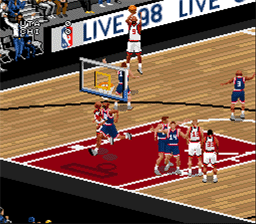 86. NBA Live 98 NBA Live 98 offers the player all teams, players and stadiums of the 1998 NBA season. More than 350 faces got scanned to improve realism. Also some new moves like crossover or fade-aways are implemented. You can play single games, whole seasons, the playoffs or new things like manager career or 3-point-shootout in the style of an all-star-game. |
|
|
|
Post by Seth Drakin of Monster Crap on Oct 22, 2007 14:33:05 GMT -5
Now for the countdown update
150. King Of The Monsters
149. Captain America And The Avengers
148. Bugs Bunny Rabbit Rampage
147. Cannon Fodder
146. Wayne's World
145. Madden NFL 95
144. Metal Warriors
143. Super Godzilla
142. Spider-man & Venom: Separation Anxiety
141. Clay Fighter
140. Super Bomberman 2
139. X-Men: Mutant Apocalypse
138. Kirby's Avalanche
137. Striker
136. Fatal Fury Special
135. King Of Dragons
134. Rap Jam: Volume One
133. Disney's Magical Quest
132. Doom
131. Samurai Shodown
130. International Superstar Soccer
129. Breath Of Fire
128. Sim City 2000
127. U.N. Squadron
126. Desert Strike: Return To The Gulf
125. Daffy Duck: The Marvin Missions
124. Super Battleship
123. S.O.S.
122. Gradius III
121. Tetris 2
120. Lufia II: Rise Of The Sinistrels
119. The Lion King
118. Spider-man & Venom: Maximum Carnage
117. Demon's Crest
116. Pinball Fantasies
115. Inindo: Way Of The Ninja
114. World Cup Striker
113. Run Saber
112. NCAA Football
111. Krusty's Fun House
110. The Simpsons: Virtual Bart
109. Cool Spot
108. Tecmo Secret Of The Stars
107. Super Caesar's Palace
106. Pilotwings
105. Road Runner's Death Valley Rally
104. Romance Of The Three Kingdoms IV: Wall Of Fire
103. Teenage Mutant Ninja Turtles: Tournament Fighters
102. Riddick Bowe Boxing
101. Saturday Night Slam Masters
100. Super Return Of The Jedi
99. Shadowrun
98. Kirby's Dream Course
97. Rock N' Roll Racing
96. NHL 94
95. Madden NFL 97
94. Paladin's Quest
93. Axelay
92. Advanced Dungeons & Dragons: Eye Of The Beholder
91. Wrestlemania: The Arcade Game
90. FIFA International Soccer
89. Super Tennis
88. King Arthur's World
87. Terranigma
86. NBA Live 98
Here Are The Hints To The Next Five Games On Our List
* Blaze The Sky
* Im Feeling Super Being At Wrestlemania
* More Advanced QB Functions
* The Alpha Game
* Set Your Soul Ablaze
|
|
|
|
Post by The Portable Stove on Oct 22, 2007 15:33:53 GMT -5
Here Are The Hints To The Next Five Games On Our List * Blaze The Sky * Im Feeling Super Being At Wrestlemania * More Advanced QB Functions * The Alpha Game * Set Your Soul Ablaze The second one... uh... WWF Royal Rumble?  I'll just say "Street Fighter Alpha 2" and move on. |
|
|
|
Post by piehead on Oct 22, 2007 17:04:18 GMT -5
* Blaze The Sky - Skyblazer
* Im Feeling Super Being At Wrestlemania- Super Wrestlemania
* More Advanced QB Functions - No idea about American Football so ill guess NFL Quarterback club 96
* The Alpha Game- Street Fighter Alpha
* Set Your Soul Ablaze - Soul Blazer
How did I do?
|
|
|
|
Post by Seth Drakin of Monster Crap on Oct 22, 2007 17:10:59 GMT -5
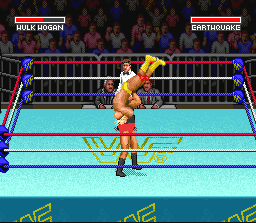 85. WWF Super Wrestlemania WWF Super WrestleMania is a multiplatform wrestling game released in 1992 by LJN for the Super NES and Sega Genesis gaming systems. All wrestlers share the same set of standard wrestling moves like scoop slams, suplexes, dropkicks, clotheslines, hip tosses, and elbow drops. The Genesis version also has signature moves for each wrestler that can be hit at any time in the match. While the SNES version doesn't contain signature moves, its roster is a bit larger, with ten wrestlers compared to the Genesis version's eight. Gameplay modes consist of One-on-One, Tag Team, and Survivor Series. The Genesis version also contains a WWF Championship mode where the player selects one wrestler and must defeat the rest in a series of one-on-one matches to be crowned WWF Champion. Wrestlers Featured Are: * Road Warrior Animal * Earthquake * Road Warrior Hawk * Hulk Hogan * Jake "The Snake" Roberts * "Macho Man" Randy Savage * Sid Justice * "Million Dollar Man" Ted Dibiase * Typhoon * The Undertaker |
|
|
|
Post by Seth Drakin of Monster Crap on Oct 22, 2007 17:13:47 GMT -5
 84. Skyblazer Skyblazer is a SNES platform video game released by Sony Imagesoft in early 1994. It involves the Skyblazer hero searching for Ashura, the Lord of War, who had kidnapped the sorceress Ariana. Skyblazer was obscure at the time of its release, but has received respectable reviews from those who have played it. There are a total of 17 levels (with a few more stops on the map where the elder gives passwords to the player) and ten bosses (including the final boss, Raglan; the other nine bosses must each be fought twice, since they reappear immediately before Raglan.) An overhead map allows for movement between levels, including back to ones already completed, and its slight non-linearity allows one to skip some levels (at the cost of the magic spells and other powerups obtainable in them.) Most of the levels are side-scrolling, but there are some levels involving flight, either automatically scrolling or in Mode 7, where the player can grab crystals towards extra lives but will exit the level upon touching a spike and falling. Also, some levels expand on the usual platform structure by including waterways whose paths can be varied with switches, and there are areas with rotating towers. Many of the bosses also use extensive Mode 7, expanding and rotating around the screen or coming in the form of rotating walls. There are eight secondary attacks available beyond the basic punch and kick, but unlike those they require magic power: * Aura Attack — This basic secondary attack is always available with enough magic power, even before completing any levels. It fires a small curved wave with moderate attack power. * Comet Flash — Sky jets straight forward, allowing him to traverse long pits of spikes, lava and other dangers. * Lightning Strike — Full-screen lightning blast. * Star Fire — Shot goes outward in nine directions from the player. * Heal — Self-explanatory. * Warrior Force — Temporary invulnerability and doubled attack power. * Time Stop — Temporarily stops enemy motion; only works on one boss. * Fiery Phoenix — The only weapons that can penetrate Ashura's defense. Magic powerups, signified by flasks of red liquid in either small or large sizes, can replenish the power needed to use these. Palette-swapped flasks of green fluid restore health. There are gems of both small and large sizes; a large gem counts the same as 10 small ones, and obtaining 100 gems will give a player an extra life (much like Super Mario Brothers coins.) There are also outright 1-ups. |
|
|
|
Post by Seth Drakin of Monster Crap on Oct 22, 2007 17:19:08 GMT -5
 83. Madden NFL 98 Playcalling expert John Madden again licenses Electronic Arts' flagship football simulation. New features for 1998 include more advanced Quarterback functions such as the ability to play lob passes and adjust timing patterns, and more instinctive AI features to adjust as the match goes on. Squad features have also been advanced, with the opportunity to create plays and trade them. Gameplay is much the same as the other editions, with the full season on offer as well as playoffs and the Superbowl. Everything is presented TV-style, with play-by-play analysis and reports. The contemporary NFL teams are joined by great squads of the past. |
|
|
|
Post by Seth Drakin of Monster Crap on Oct 22, 2007 17:21:48 GMT -5
 82. Street Fighter Alpha 2 This was released in 1996 as an update to the original SFA. The story behind this game is an override of those found in Alpha, and canonically, all but one ending (Charlie's) occurred. Alpha 2 brought back every character from Alpha, including the hidden characters Dan, Akuma, and M. Bison. Alpha 2 also brought back Gen, from the original Street Fighter, and Zangief and Dhalsim from Street Fighter II (the latter two allegedly due to popular demand), as well as Rolento from the Final Fight series. Sakura made her first appearance in this game. The English localizations of the Arcade and Saturn versions features three new characters not found in the Japanese originals, which consisted of Evil Ryu (a version of Ryu with Akuma's powers) and classic versions of Dhalsim and Zangief that had no super moves and played like their original versions in the Street Fighter II series. Everyone was expecting Capcom to release a sequel to Street Fighter Alpha. A number of factors conspired against the release of the sequel, however. The CPS-2 board upon which the games had recently been based was essentially little more than a slightly improved CPS-1 board. Capcom was diverting resources to the development of 3D arcade games and the new CPS-3 board, which eventually debuted later in that year. As such, sparse resources were devoted to Street Fighter Alpha 2, some reports stating that at times, the team working on it was said to number one person. Despite this context, the game was released in early 1996, 8 months after the original, and garnered immediate praise from the press and public alike. Correcting what had often been the primary complaint about the first Alpha game, Alpha 2 was a significantly more polished and balanced game. Primarily, the degree to which each character's set of moves complemented the others was again addressed. Several new features were introduced in this incarnation: the chain combos were removed (although Gen and Guy could still perform a few), custom combos, a concept which would be refined in later games, were also introduced in Alpha 2 - the player could press a combination of buttons (two punches and one kick or vice versa) to initiate a state where all moves could be canceled into each other at increased speed, thus allowing the player to create their own super combos. Also, Alpha Counters were revised so that they would be variable to the situation i.e. a punch Alpha Counter would result in an anti-air counter while with kick would respond low. Rose's Alpha Counter actually switched positions with the opponent, this became a critical move if Rose used it while in the corner. The three hidden characters from SFA were made originally selectable and five new characters were added, among them old SFII faces Dhalsim and Zangief together with later favourite Sakura. This was also the first appearance of 'Shin Akuma' in the home versions, the so-called "real" Akuma, capable of throwing double fireballs mid-air and all-around superior to the normal Akuma. He was a hidden character. Numerous game magazines at the time voted SFA2 one of the best arcade games of the year, the relatively minor changes to the fundamentals of the game and the extensive polishing of the same winning formula gained general approval from competitive fans also. The game was again ported to the Saturn and PlayStation, the Saturn version again the superior port, due to the ability to select the classic Champion Edition versions of Zangief and Dhalsim, Chun-Li's original Street Fighter II outfit (complete with her original fireball motion), an Evil version of Ryu, a special version of Sakura, and Shin Akuma. A PC version was also available, though it did not carry all the hidden characters that the Saturn version had, namely the other versions of Zangief and Dhalsim, Evil Ryu and Sakura. Interestingly, due to the implementation of the S-DD1 chip that was used for graphic decompression, a conversion of this game was one of the last games on the SNES, despite the doubts about it being feasible. While it is commonly not compared favorably to the Saturn or PlayStation versions, it is a competent port, featuring all of the original characters featured in the arcade version, no other secret characters are available, though Shin Akuma can be fought against). In order to fit in the cartridge, some graphic down-scaling was done (the characters are smaller) and the animations are less fluid. |
|
|
|
Post by Seth Drakin of Monster Crap on Oct 22, 2007 17:24:48 GMT -5
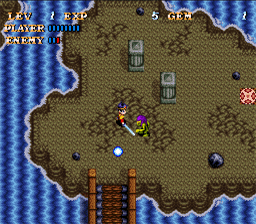 81. Soul Blazer Soul Blazer, known in Japan as Soul Blader, is a Super Nintendo Entertainment System console role-playing game developed by Quintet and published by the Enix (now Square Enix). Soul Blazer was released on January 31, 1992 in Japan, on December 31, 1992 in North America and on January 27, 1994 in Europe. Similar to the company's previous game ActRaiser, the player takes the role of a divine angel, deity or lesser-deity, or avatar, sent by a divinity, called The Master (Gaia), to destroy monsters and release the captured souls of a world's inhabitants. Soul Blazer was scored by Yukihide Takekawa. As in ActRaiser, the player frees a series of towns by fighting monsters in traditional dungeon-crawl battles (Act Raiser was side-scrolling; Soul Blazer has a top-down perspective). However, Soul Blazer eschews the SimCity-like aspect of ActRaiser. Instead, the player frees the towns incrementally — by destroying monster lairs in the dungeons, a soul belonging to a former town occupant is liberated and reincarnated. This is often a human, but it could be anything from a dolphin to a talking tulip. As souls are freed, the town is reconstructed around the people. The new town occupants give the player advice and items. When the player defeats the boss monster imprisoning the soul of the head of each town, the area is cleared and the player can continue. After the hero frees the first six villages, he is granted access to the "World of Evil" where the final villain awaits. The game's history concerns the Freil Empire, a kingdom ruled by King Magridd. Magridd learned of an inventor named Dr. Leo in his kingdom who could invent virtually anything. He had Dr. Leo imprisoned and forced him to create a machine that could be used to contact the evil spirit Deathtoll (Dark Gaia). Deathtoll offered the king one gold piece for each soul from his kingdom, and under the counsel of his wife, Magridd agrees. As a result, the villages were destroyed, all living creatures became incarcerated souls in Deathtoll's monster lairs, and the world became empty. The Master of the world sees this devastation and sends one of his heavenly divine servants to the kingdom in the form of a human warrior to defeat the monsters and liberate the inhabitants. The hero defeats the monsters in each of six areas and gathers the six magic stones (which are brown, green, blue, silver, purple, and black respectively) needed to open the path to Deathtoll in the "World of Evil", and along the way falls in love with Dr. Leo's daughter Lisa. He also finds the three sacred artifacts that he uses to call upon the power of the phoenix to defeat Deathtoll. The kingdom is restored and the King Magridd is horrified at his actions. The hero then returns to heaven, but one year later the Master realizes that the hero misses life as a human. The Master sends the hero back to the Freil Empire but under the condition that the hero will not have any memory of his past. The hero wakes up in the first town, Grass Valley, where Lisa recognizes him. Though he does not remember her, they walk off together and renew their relationship. |
|
|
|
Post by Seth Drakin of Monster Crap on Oct 22, 2007 17:39:34 GMT -5
Now for the countdown update
150. King Of The Monsters
149. Captain America And The Avengers
148. Bugs Bunny Rabbit Rampage
147. Cannon Fodder
146. Wayne's World
145. Madden NFL 95
144. Metal Warriors
143. Super Godzilla
142. Spider-man & Venom: Separation Anxiety
141. Clay Fighter
140. Super Bomberman 2
139. X-Men: Mutant Apocalypse
138. Kirby's Avalanche
137. Striker
136. Fatal Fury Special
135. King Of Dragons
134. Rap Jam: Volume One
133. Disney's Magical Quest
132. Doom
131. Samurai Shodown
130. International Superstar Soccer
129. Breath Of Fire
128. Sim City 2000
127. U.N. Squadron
126. Desert Strike: Return To The Gulf
125. Daffy Duck: The Marvin Missions
124. Super Battleship
123. S.O.S.
122. Gradius III
121. Tetris 2
120. Lufia II: Rise Of The Sinistrels
119. The Lion King
118. Spider-man & Venom: Maximum Carnage
117. Demon's Crest
116. Pinball Fantasies
115. Inindo: Way Of The Ninja
114. World Cup Striker
113. Run Saber
112. NCAA Football
111. Krusty's Fun House
110. The Simpsons: Virtual Bart
109. Cool Spot
108. Tecmo Secret Of The Stars
107. Super Caesar's Palace
106. Pilotwings
105. Road Runner's Death Valley Rally
104. Romance Of The Three Kingdoms IV: Wall Of Fire
103. Teenage Mutant Ninja Turtles: Tournament Fighters
102. Riddick Bowe Boxing
101. Saturday Night Slam Masters
100. Super Return Of The Jedi
99. Shadowrun
98. Kirby's Dream Course
97. Rock N' Roll Racing
96. NHL 94
95. Madden NFL 97
94. Paladin's Quest
93. Axelay
92. Advanced Dungeons & Dragons: Eye Of The Beholder
91. Wrestlemania: The Arcade Game
90. FIFA International Soccer
89. Super Tennis
88. King Arthur's World
87. Terranigma
86. NBA Live 98
85. WWF Super Wrestlemania
84. Skyblazer
83. Madden NFL 98
82. Street Fighter Alpha 2
81. Soul Blazer
Here Are The Hints To The Next Five Games On Our List
* Gaia Creates An Illusion
* Griffey Scores A Winning Run
* Nameless Here For Evermore
* The Skull Cross Gang Is Now In Control
* Vic Viper, Octopus, Twinbee, & Pentarou
|
|
|
|
Post by Z-A Sandbaggin' Son of a b!%@h on Oct 22, 2007 18:01:54 GMT -5
Illusion of Gaia
Ken Griffey Baseball
|
|
|
|
Post by Joker on Oct 22, 2007 18:16:33 GMT -5
That was a screenshot of Super Street Fighter 2 ... not the alpha series! (Minor point and I'm nit picking) lol
Good results so far, King Arthurs World rock!!
|
|
|
|
Post by The Portable Stove on Oct 22, 2007 18:16:34 GMT -5
PARODIUS!
...oh, and Final Fight 3.
|
|